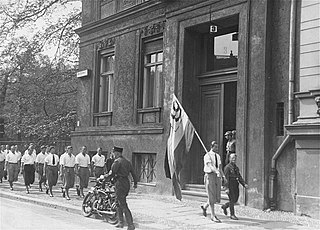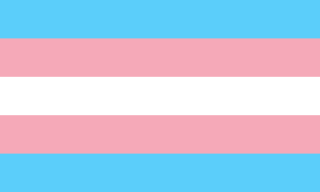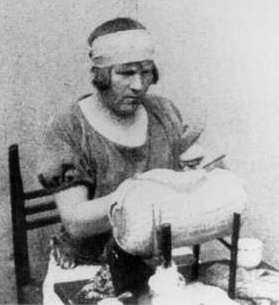
Cross-dressing is the act of wearing clothes traditionally or stereotypically associated with a different gender. From as early as pre-modern history, cross-dressing has been practiced in order to disguise, comfort, entertain, and express oneself.

Sexology is the scientific study of human sexuality, including human sexual interests, behaviors, and functions. The term sexology does not generally refer to the non-scientific study of sexuality, such as social criticism.
Transvestism is the practice of dressing in a manner traditionally or stereotypically associated with a different gender.

Magnus Hirschfeld was a Jewish German physician and sexologist, whose citizenship was later revoked by the Nazi government. Hirschfeld was educated in philosophy, philology and medicine. An outspoken advocate for sexual minorities, Hirschfeld founded the Scientific-Humanitarian Committee and World League for Sexual Reform. He based his practice in Berlin-Charlottenburg during the Weimar period. Performance Studies and Rhetoric Professor Dustin Goltz characterized the committee as having carried out "the first advocacy for homosexual and transgender rights".

Harry Benjamin was a German-American endocrinologist and sexologist, widely known for his clinical work with transgender people.

The Institut für Sexualwissenschaft was an early private sexology research institute in Germany from 1919 to 1933. The name is variously translated as Institute for Sexual Research, Institute of Sexology, Institute for Sexology, or Institute for the Science of Sexuality. The Institute was a non-profit foundation situated in Tiergarten, Berlin. It was the first sexology research center in the world.
Gender expression, or gender presentation, is a person's behavior, mannerisms, and appearance that are socially associated with gender, namely femininity or masculinity. Gender expression can also be defined as the external manifestation of one's gender identity through behavior, clothing, hairstyles, voice, or body characteristics. Typically, a person's gender expression is thought of in terms of masculinity and femininity, but an individual's gender expression may incorporate both feminine and masculine traits, or neither. A person's gender expression may or may not match their assigned sex at birth. This includes gender roles, and accordingly relies on cultural stereotypes about gender. It is distinct from gender identity.

Sexuality in transgender individuals encompasses all the issues of sexuality of other groups, including establishing a sexual identity, learning to deal with one's sexual needs, and finding a partner, but may be complicated by issues of gender dysphoria, side effects of surgery, physiological and emotional effects of hormone replacement therapy, psychological aspects of expressing sexuality after medical transition, or social aspects of expressing their gender.
David Oliver Cauldwell was a prolific and pioneering sexologist, who coined the term transsexual as used in its current definition. Many of his monographs on sex, psychology, or health were published by Emanuel Haldeman-Julius in such forms as Big Blue Books. He was the editor of Sexology magazine's question and answer department. Cauldwell and Harry Benjamin were "two early and important American voices on transsexuality".

A transgender person is someone whose gender identity differs from that typically associated with the sex they were assigned at birth. Some transgender people who desire medical assistance to transition from one sex to another identify as transsexual. Transgender is also an umbrella term; in addition to including people whose gender identity is the opposite of their assigned sex, it may also include people who are non-binary or genderqueer. Other definitions of transgender also include people who belong to a third gender, or else conceptualize transgender people as a third gender. The term may also include cross-dressers or drag kings and drag queens in some contexts. The term transgender does not have a universally accepted definition, including among researchers.

A transsexual person is someone who experiences a gender identity that is inconsistent with their assigned sex, and desires to permanently transition to the sex or gender with which they identify, usually seeking medical assistance to help them align their body with their identified sex or gender.

Dora Rudolfine Richter was a German trans woman and the first known person to undergo complete male-to-female gender-affirming surgery. She was one of a number of transgender people in the care of sex-research pioneer Magnus Hirschfeld at Berlin's Institute for Sexual Research during the 1920s and early 1930s. She underwent surgical removal of the testicles in 1922, followed in 1931 by removal of the penis and vaginoplasty. It is unclear what happened to Richter after 1939, and both the cause and date of her death are unknown.

Gesetze der Liebe: Aus der Mappe eines Sexualforschers is a 1927 film produced by Magnus Hirschfeld, a sexologist who ran the Berlin Institut für Sexualwissenschaft, Hermann Beck and the Humboldt-Film-Gesellschaft.

The Transsexual Phenomenon is a medical textbook published by American endocrinologist and sexologist Harry Benjamin in 1966 with The Julian Press. The text is notable for its examination of transsexualism not as a psychological issue, but rather as a somatic disorder that should be treated through medicine. Benjamin argues that transvestism and transsexuality are a spectrum of conditions, requiring different treatments that ranged from hormone replacement therapy to surgical intervention.
Das 3. Geschlecht, subtitled Die Transvestiten ("Transvestites"), was a transvestite magazine of Weimar Germany, published from 1930 until 1932 in Berlin. Published by the Radszuweit publishing house, it is believed to be the first transvestite magazine in history. A predecessor to the magazine was Die Freundin, a more lesbian-focused magazine that nonetheless published some columns appealing to transvestites.

The first homosexual movement was a socio-political movement which thrived in Germany from the late nineteenth century until 1933. The movement began in Germany because of a confluence of factors, including the criminalization of sex between men and the country's relatively lax censorship. German writers in the mid-nineteenth century coined the word homosexual and criticized its criminalization. In 1897, Magnus Hirschfeld founded the world's first homosexual organization, the Scientific-Humanitarian Committee, whose aim was to use science to improve public tolerance of homosexuality and repeal Paragraph 175. During the German Empire, the movement was restricted to an educated elite, but it greatly expanded in the aftermath of World War I and the German Revolution.

Gerd Katter was a German apprentice carpenter, insurance agent and patient of the notable German physician and sexologist, Magnus Hirschfeld.

Transgender genocide or trans genocide is a term used by some scholars and activists to describe an elevated level of systematic discrimination and violence against transgender people.

In Nazi Germany, transgender people were prosecuted, barred from public life, forcibly detransitioned, and imprisoned and killed in concentration camps. Though some factors, such as whether they were considered "Aryan", heterosexual with regard to their birth sex, or capable of useful work had the potential to mitigate their circumstances, transgender people were largely stripped of legal status by the Nazi state.

Paragraph 183 is a public indecency law of the German Criminal Code, which prohibits "sexual self-determination" and public exhibitionism. From its adoption in 1871, at an increasing rate during the rise of the Nazis, and until as late as the mid-20th century, the law was used to enforce penalties for cross-dressing and homosexual acts. As of 2021, the law's scope is limited to indecent exposure.






















